by Dan La Botz, Robert Brenner, and Joel Jordan
August 9, 2012
The Occupy Movement, the first such broad, national, multi-issue, mass movement in forty years, represented a test for the revolutionary socialist left in several senses. First, would the left recognize its important and immediately move to become an active part of it and work within it to help provide leadership? Second, would the left during Occupy be able to both appreciate its strengths and develop a critique of its weaknesses and limitations? Would it as the same time be able to conduct socialist propaganda and recruit to the socialist movement? Third, would the left in retrospect be able to analyze and learn from the Occupy experience in order to prepare itself for future movements?
The following document is seen as part of the process of understanding and analyzing Occupy and what proved to be the most important development of the Occupy movement–its interaction with the labor unions. This interaction represented the greatest challenge to the movement and to those of us who seek to understand it and learn from it.
The Movement Begins: Occupy! We are the 99%
The Occupy Wall Street movement – beginning in Zuccotti Park near Wall Street in New York City in mid-September 2011 crying out against the overbearing power of the corporations, the enormous inequities of American society, and the inordinate role of money in politics – spread within a few weeks across the country. The brilliant slogan “We are the 99%” captured the imagination not only of the participants, but of large swathes of the broader American public as well, and for good reason. Over the previous decades, there had been an epoch-making upward re-distribution of income to the top 1% and above, and capital and the rich had established the sort of stranglehold on politicians and government not seen since the Gilded Age. During the fall months of 2011, thousands participated in Occupy encampments in cities from coast to coast while tens of thousands participated in marches and protest demonstrations organized by the movement, and Occupy emerged as the largest and most important social movement in the United States since the 1960s and 70s. Occupy Wall Street and its offspring were the first serious response from working people and the citizenry at large to the economic crisis of 2008, playing the role that in another country or in earlier times might have been played by a mass labor movement or an emergent populist or socialist party. Occupy’s declaration represented a wide-ranging radical challenge to the economic and political establishment and to the status quo such as we had not seen since the civil rights/Black Power struggle, the anti-war movement, and Students for Democratic Society (SDS).
When the Occupy movement began, the rightwing Tea Party movement dominated American newspapers, radio and television news and commentary, but almost from the moment that it appeared, Occupy took center stage. Virtually the entire political establishment was pushing austerity as its basic response to the economic crisis, and, only weeks before the Obama administration, following its own Bowles-Simpson commission, had proposed a “grand bargain” for reducing government spending and balancing the budget, especially by reducing social security, Medicare, and Medicaid. But, in a matter of months, the Occupy movement had changed the national conversation from the Tea Party’s rightwing agenda of tax-cuts and budget cuts to discussions of the inordinate salaries and bonuses of the bankers and CEOs, the financial contributions of the wealthy to the politicians, and, above all, the economic crisis facing tens of millions of Americans. Obama himself had to drop, for the time being—until after the election—all talk of belt-tightening. Occupy criticized the continuing high rate of unemployment, the foreclosures on homeowners, the inadequacy of the health system (including Obama’s health plan), and the crisis in the costs of higher education. While never explicitly anti-capitalist and certainly not pro-socialist, Occupy’s critique of the economy and politics tended to challenge the system as a whole—and the system was capitalism even if it usually went unnamed. The movement’s cry, “We are the 99%!” rang out not only in the stone canyons of Wall Street, but also in cities, towns, and university campuses across the United States and soon reverberated around the world as Occupy sites were established in countries in Europe and Latin America.
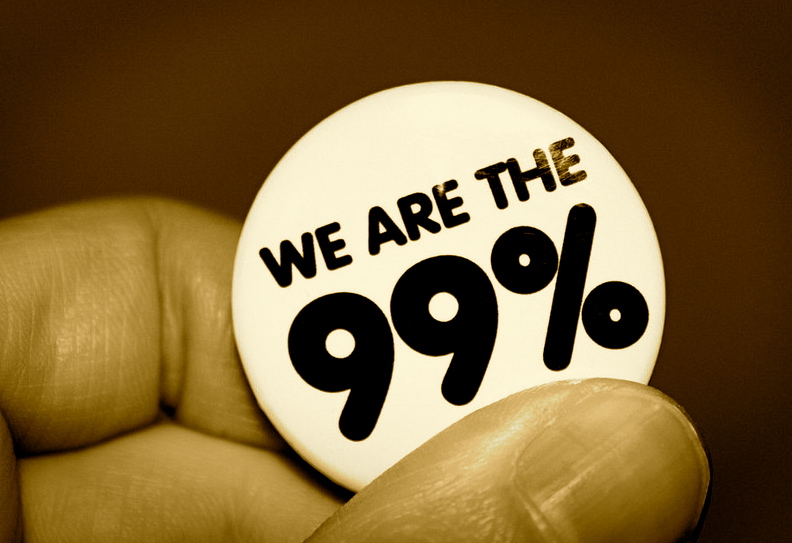
The International Context
The Occupy movement in the United States arose, in part, out of the succession of extraordinary mass struggles that exploded onto the global scene in response to the world economic crisis, demanding democracy and opposing austerity. The Arab Spring that began in December 2010 saw huge social movements against the region’s dictators that in the following months forced governments from power in Tunisia, Egypt, Libya and Yemen. At the same time there were major uprising and huge social protests in Algeria, Bahrain, Iraq, Jordan, Kuwait, Morocco and Syria and other countries in the Arab world and in Muslim countries in Africa. The protests in Tahrir Square involving tens of thousands in January of 2011 provided the model of the occupation of the public square, as Egyptians engaged in massive civil disobedience which had been preceded by and was accompanied by strikes. Demands for an end to the Mubarak government and its fierce repression combined with demands for lower prices and higher wages. At the same time, in Israel, a social justice protest movement of hundreds of thousands arose over issues of inflation, health care and education, crying, “We want social justice!”
Inspired by Egypt and the Arab Spring, in Spain groups such as Juventud sin Futuro (Youth without a Future) and others brought together hundreds of smaller organizations, all of them calling upon young unemployed workers to occupy the public plazas on May 15, giving rise to the M-15 or indignado movement. The indignados demanded jobs, opposed cuts in social welfare, and opposed the Spanish political system and its parties. By June the demonstrations had spread to 80 Spanish cities and the occupations of the plaza were accompanied by huge protest demonstrations and marches.
In Britain, France, Spain, Portugal, Italy and Greece, especially in Greece, there were also in this period large labor union protests and strikes, particularly of public sector workers, including general strikes against austerity. All of the protests and upheavals in both Europe and the Arab world represented responses to the economic crisis of 2008, though as in the case of Tunisia, Egypt and other Arab countries, the crisis also provided the occasion to deal with longstanding issues of authoritarian governments, the lack of political and civil rights, and the poverty of millions. In those cases, the crisis was the detonator of long pent up explosive forces in the society.
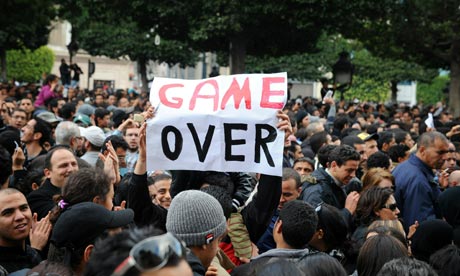
“Game over” for Ben Ali in Tunisia. Photo: Fethi Belaid/AFP/Getty Images
The Background of Occupy in United States
The Occupy movement’s antecedents can be found most clearly in the anti-globalization and global justice movement that preceded and then rapidly expanded after the Battle of Seattle, the massive environmental and labor protests against the World Trade Organization’s Ministerial Conference in Seattle, Washington in 1999. The Battle of Seattle, bringing together a range of environmental organizations and unions such as the United Steel workers, Teamsters, and International Longshore and Warehouse Union to shut down the streets of Seattle, provided a model of militant direct action against corporate globalization. Never anti-capitalist, the global justice movement’s massive and militant demonstrations of radical youth, environmentalists, and labor unions at a series of international trade and policy meetings of government and corporate leaders around the world over several years represented a significant, radical social movement, if not a national mass movement such as we had seen in the 1960s and 1970s or as we saw again with the coming of Occupy.
The immediate predecessor of Occupy Wall Street was the Wisconsin protest of 2011 against Governor Scott Walker’s anti-union legislation, which saw tens of thousands, and at moments as many as 100,000 people protest at the capitol building, as thousands actually occupied the building, and teachers engaged in wildcat strikes. The Wisconsin protests—though the labor bureaucracy and the Democratic Party ended them as quickly as possible and then succeeded in channeling the movement into the recall efforts and electoral politics—provided the model of the occupation of public space, mass protests by working people, and wildcat strikes. Wisconsin, occurring at the same time as the Egyptian occupation of Tahrir Square provided the prototype for Occupy Wall Street.
The extraordinary potential of the Occupy movement, and the threat it came to represent to today’s political-economic establishment, resulted from its ability to speak effectively to the unprecedented concatenation of politico-economic cum ideological conditions that emerged with the outbreak of the global crisis from 2007-2008. The historic movements of the 1960s had arisen at the high point of postwar capitalist prosperity and profitability, in the wake of more than two decades of unprecedented real wage increase for large sections of the working class, and at a time at which the surpluses/taxes/income available to the political establishment enabled it to respond to mass pressure from below with a succession of substantive reforms and with relatively little coercion (leaving aside, of course, the unending campaign of repression against the Black movement, especially as it moved into the northern cities and extended its program from rights to socioeconomic justice). The sustained improvement in living standards for large sections of the population brought capitalism to the height of its prestige, while the expansion of the welfare state had the effect of strengthening the then hegemonic statist-liberal ideology and the political parties and institutions associated with it (including, to a greater or lesser degree, the Republican Party). As a consequence, the mass movements of the period never found a basis for challenging capitalism as a system and could be, and were, re-absorbed to a large degree within the left-wing of the political mainstream, the liberal wing of the Democratic Party.
In telling contrast, Occupy emerged four years into the worst economic crisis since the Great Depression, which had itself broken out at the end of a very extended period of slowed growth, stagnation, and relative decline for American capitalism. Average real wages had failed to rise for close to four decades, the welfare state had virtually stopped growing, and inequality of income and wealth had reached levels not seen since the nineteenth century. Both political parties had long since ceased even to promise significant social reform, but devoted themselves, for the most part, to the use of the state as an engine of plunder and upward redistribution of wealth.
Both parties and all wings of the capitalist class were completely committed to the neoliberal ideology that dominated the globe, but neoliberalism had little to offer the great majority of the working class, whose members, to the extent they possessed any sort of economic world view, probably accepted that “there is no alternative.” The old stalwarts of statist liberalism, the vastly diminished trade union movement and Black movement, remained nominally committed to it, but were so dependent upon the DP, and so profoundly weakened by that long term position, that they were incapable of pushing for it; statist liberalism was dead, practically speaking. Meanwhile, the DP, led by its actually dominant DLC, took these forces entirely for granted while attempting to cement their ties with sections of capital and conservative constituencies in the South and elsewhere.
The great housing price run-up of the decade before the crash of 2008 may well have provided the material basis for something of a renewed commitment to the free market for a not insignificant part of the population. But, when the housing bubble burst and the Great Recession ensued, bringing widespread misery, the willingness of the political elite to provide trillions to bail out the financier-lenders, while doing nothing whatever for the great mass of household-borrowers, brought deep disillusionment and an instant discrediting of the system, along with a profound anger at the bankers and the politicians who obviously served them. It was this sudden far-reaching, but hitherto largely unexpressed alienation on the part of broad sections of the working class from a political-economic system that was offering them only worsening economic conditions and deepening humiliation that opened the way for Occupy.
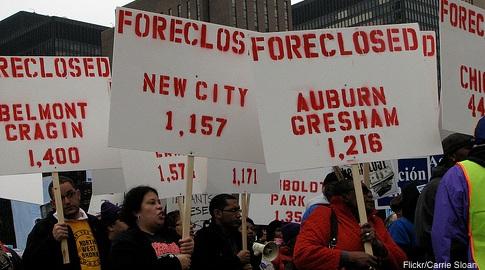
The Nature of Occupy
Occupy, because it was a national movement across the United States where economic, social and political conditions vary greatly, necessarily had different experiences and different characteristics in different areas. Yet it also had many commonalities. We might note some of the differences: Occupy Wall Street involved far more students and youth than most other Occupy sites. While most Occupy groups were mostly white, there were in Atlanta and Oakland larger numbers of African Americans and Latinos. There were also commonalities: Occupy was in part a coming together of activists from many movements. Watching any of the demonstrations in any city on any day, one saw pass by demonstrators wearing T-shirts and jackets with all the logos of all the movements that have touched the country in the last two decades: anti-war, LGBTQ, foreclosures, unions, and civil rights. Walking among them were others new to the movement, blue collar and white collar workers, often carrying their hand painted signs with slogans like “Create Jobs, Reform Wall Street, Tax the Wealthy More,” and “The People are Too Big to Fail” (a reference to the argument that the U.S. government had to save the banks because they were “too big to fail”). The sense of optimism that the movement was creating was expressed by one sign down at Wall Street that read, “This Is the First Time I’ve Felt Hopeful in a Very Long Time.”
The movement had a utopian character in the best sense of that word. Many of those involved in Occupy wanted not only to overcome the immediate effects of the economic crisis—they wanted a better life, a better country, a better world. Many joined the movement because of the sense of community that it had created; a community which they believed prefigured in a small way the national community they desired. The movement as such had no ideology. Occupy was populism of a left wing sort: the people versus big business and bad government. Though there are anarchists and they gave it some of their style, it is not an anarchist movement. Though there are some socialists in it, the movement is by no means socialist. What was perhaps best and most exciting about the movement was the confluence of the many social movements with middle class and working class people who have come down to Wall Street or in some other town or city down to Main Street to say, “We’ve had it.” The utopianism of the movement has inspired ordinary people to think and to say, “We can live differently, we must, and we will.”
The Rejection of Politics
The Occupy movement defined itself negatively as the rejection of traditional social movements and political organizations which had so often failed. Movements, unions and parties all had representative and delegated leadership structures where the leaders soon escaped the control of the members. Occupy would have none, adopting the old slogan: “We are leaderless. We are all leaders.” Other organizations operated through cumbersome forms of government and administration which made government opaque. Occupy would operate simply through its apparently transparent general assemblies and its participatory and autonomous action committees. Other groups made demands. Occupy declined to make specific demands in large part as a defense against cooptation by the Democratic Party, the labor unions, and the left all of which urged the movement to define itself by a list of economic and political demands. Demands seemed to be the first step toward institutionalization and co-optation. While all of Occupy’s practices may be criticized, they arose as part of a healthy rejection of everything of the undemocratic, bureaucratic, and stifling about typical movements, unions and parties. Occupy represented an idealistic if naïve attempt to begin society and politics anew, transparent, democratic, and participatory.
Occupy generally rejected politics in all its many varieties. Politicians of the usual Democratic Party sort were generally unwelcome. Socialist speech making, so often condescending, and the distribution of socialist literature, so often pretending to direct the movement, was seen as divisive and frowned upon. The Libertarian Party and the Ron Paul supporters who at moments colonized Occupy were tolerated only as individuals, not as partisans. The Green Party generally received greater tolerance, since it was perceived to share the Occupy movement’s general environmentalist sentiments. Occupiers often spoke against political parties and candidates, but almost never in favor them. Yet, while it was hostile to politics in the electoral sense, Occupy was, despite its apolitical character, a kind of unofficial party of the exploited and oppressed 99%.
The Threat Represented by Occupy
The Occupy general assemblies, however ill-conceived and difficult their actual functioning, represented a model of participatory democracy in dramatic contrast to the undemocratic character of American government and administration at all levels. Occupy’s kitchens, libraries, medical services, and security teams all organized on a voluntary and cooperative basis provided an alternative model of society. The occupation of public parks and other public spaces in urban areas provided both an assembly point and a staging array for forays into the heart of the city to challenge powers-that-be and to mobilize society’s underdogs and its disaffected. Occupy sites throughout the country became a rallying point for unemployed twenty- and thirty-somethings, for older workers, some of them corporate employees and professionals who had lost their jobs, for students facing high tuitions and mounting debts, for labor union activists, leftwing radicals, and for the homeless who had been living in the parks before the movement began.
The combination of a radically democratic movement, with the socially disaffected, and with workers employed and unemployed, together with leftists, and all of it taking place in the heart of the city and poised to mobilize at a moment’s notice in forays against banks and corporations, posed a serious threat not only to city governments and the corporate elite headquartered downtown, but also represented a general and potentially more dangerous threat to the system and the state precisely because it might be only the beginning. The perception of this threat would lead to massive and sometimes brutal repression by the mostly Democratic Party mayors and city councils throughout the country, apparently in coordination with the Obama administration in Washington. Occupy encampments were demolished, as occupiers were manhandled and roughed up, beaten, gassed, and arrested by the hundreds. Throughout the country there were thousands of legal actions against occupiers ranging from tickets and fines to misdemeanor and felony indictments. Altogether there were 7,361 arrests in 117 cities in the United States between September 2011 and July 2012. The authorities also sought to link Occupy to leftwing group and brought charges of terrorism and use of violence against persons in Cleveland and Seattle who could be linked to or had been involved in or been on the periphery of Occupy movement. The repression of the Occupy movement with its thousands of arrests, its brutality, and its allegations of terrorism can only be compared to the Wilson’s repression in World War I, the Red Scare of the 1920s, the McCarthyism of the 1950s, and the violence against the African American movement in the 1960s and 1970s.
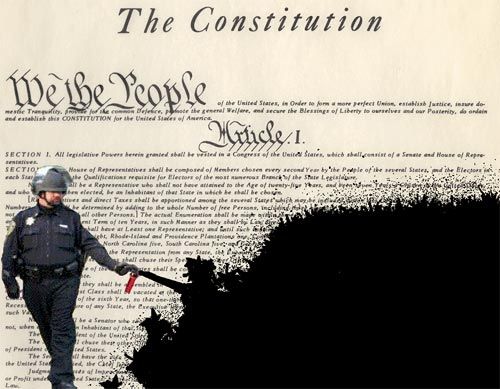
An incident of police brutality at Occupy UC Davis, involving the casual pepper spraying of students engaging in non-violent civil disobedience, quickly became an internet meme.
Occupy and the Unions
Some union activists, of course, had been involved in Occupy Wall Street from the very beginning. The AFL-CIO and major international unions initially reacted quite positively to Occupy, offering it support and resources. During early October, 2011 , when Occupy Wall Street movement was threatened with eviction, Rich Trumka, president of the AFL-CIO spoke out in support of Occupy Wall Street. At the same time several major New York public sector unions, led especially by Transport Workers Union Local 100, turned out thousands of their members to support OWS in a huge and dynamic demonstration in Foley Square, which gave a hint of the huge political potential of an alliance between Occupy and the labor movement. This was not simple solidarity; it was also an attempt by the unions to tap into the new movement’s sudden and spectacular success in mobilizing thousands against corporate power and social inequality. Unions not only mobilized their members in early October, they also donated money, provided food, and in the case of the United Federation of Teachers provided space for Occupiers. The unions returned to support Occupy in the huge action of November 17 when tens of thousands marched in NYC and thousands more in other cities around the country and around the world.
The appearance of the unions thrilled the Occupiers who suddenly saw their movement swell, but it also threatened them. The presence of Transport Workers Union Local 100, the union that runs the cities trains and buses, was particularly encouraging to the movement. Yet many Occupiers felt that the unions had their own agenda, and some worried that agenda included support for the Democrats and the presidential campaign of Barack Obama, who many occupiers saw as responsible for or at least complicit in the government’s pro-corporate policies. The unions’ ability to mobilize thousands of workers both astonished and frightened Occupiers who felt that they might simply be overwhelmed by the labor movement.
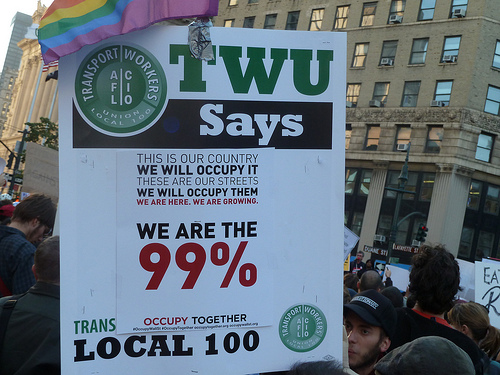
Occupiers Thrilled and Threatened by the Unions
The Occupiers fears deepened when Mary Key Henry, the president of the Service Employees International Union (SEIU), speaking just before the November 17 mobilization, invoked Occupy’s 99% slogan as she endorsed Obama for reelection. She then went on to be arrested with the Occupiers at the Brooklyn Bridge, apparently using Occupy to promote herself, the SEIU, and the Obama campaign. Many Occupiers felt fearful as the shadow of SEIU, one of the country’s largest and fastest growing labor unions, began to fall over the movement.
Occupiers, many of them more middle class than working class, and many young and without any union experience, didn’t know much about unions or how to deal with them. Few recognized that unions themselves were complex organizations, or that different unions had different politics, and that union leaders and rank-and-file members often had quite different interests. A few Occupiers, often socialists who had worked with unions, were savvier about the ins-and-outs of the union movement. Some of them in New York City, aware of a lockout by Sotheby’s auction house of 43 members of Teamster Local 814, had organized Occupiers to join the Teamsters in September in disrupting an auction and “shaming” patrons. While the Occupy labor committee helped the Teamsters in their protests against the lockout, a deep or lasting relationship between Occupy and the union was never built.
In Chicago, where socialists organized a strong labor support committee and worked in alliance with reform-minded officials, rank-and-file groups, and leftist union members, relations between Occupy and the unions grew close. Occupy Chicago’s labor support committee organized a labor meeting in January of 2012 to discuss how to resist austerity that involved about 150 union activists. A local socialist Occupy activist described a “partnership” there between Occupy, the unions and community activists. The key factors in Chicago Occupy’s construction of successful relations with the unions seem to have been the presence of a large number of socialists, the existence of a rank-and-file caucus that had recently taken power in the Chicago Teachers Union, and local union officials anxious to find support for their various beleaguered organizations. The fact that there was not more conflict in Chicago between Occupy and the unions may be because the unions engaged in no mass struggles where Occupy’s more militant tactics might have challenged them.
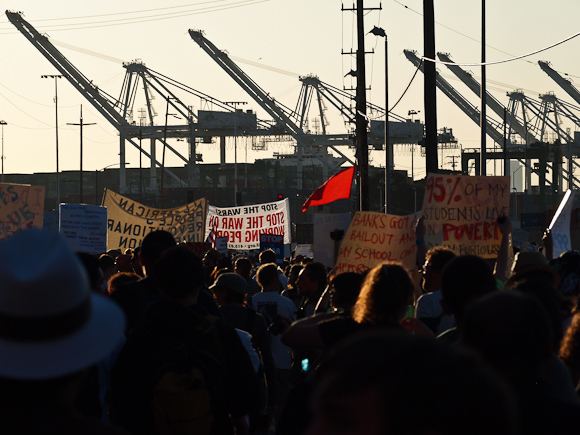
Occupy Oakland shuts down the port. Photo: Isaac Steiner
Occupy Oakland and the Port Shutdown
Occupy Oakland involved many activists from a militant multi-national working class community as well as a large number of socialists and anarchists from a variety of organizations. In order to deal a blow against the 1% and to support the ILWU’s longshoremen who were involved in a contract dispute in Longview, Washington, thousands of Occupy Oakland activists shut down the Oakland Ports more or less successfully on November 2, and again on December 12. While not entirely successful, the actions undertaken represented some of the largest, most militant, direct confrontations between working people and capital in decades, not only on the West Coast but anywhere in the United States. The ILWU, challenged by the Occupy movement’s militant direct action approach which threatened the union’s established relationships with the corporations that owned and managed the ports and docks, reacted by breaking off relations with Occupy. At one point ILWU officials from one local disrupted a meeting and assaulted Occupy and rank-and-file ILWU activists.
Why did the ILWU, one of the best unions in the country, turn in the end against Occupy? Labor unions in the United States, including those like the ILWU that we may consider to be the best, are dominated by a bureaucratic caste of privileged officials who have completely identified with the union as an organization. Their interests are in preserving the union as an institution and in maintaining their positions within that institution, rather than fighting for their rank-and-file members. On the contrary, in fact, if their rank-and-file members fight, threatening to unsettle their relationship to the employers or the government, they generally react quickly, often in collusion with management, to suppress the rank and file. The fight by rank-and-file members of the ILWU and Occupy Oakland which arose over the shutdown of the Oakland ports and Occupy’s involvement in the Longview struggle, led the ILUW national leadership and local officials to move to suppress both their own members and Occupy activists. In the end, the ILWU, forced the Longview local to accept sight unseen a labor contract with the employer and local officials were disciplined to have nothing to do with Occupy.
While this has been—with the exception of brief and intense moments of class conflict and major upheaval—the common reaction of labor union officials throughout the history of the American union movement, from the days of the AFL’s craft unions, through the CIO’s industrial unions, and through the AFL-CIO heyday in the “Golden Age” of American capitalism in the 1940s to 1960s, today union officials are likely to react even more quickly and vigorously to repress rank-and-file movements and class struggles because it is clear that in order to win, any fight will have to be tremendous. Such tremendous battles would turn the union movement upside down, no doubt breaking up old structures, ejecting all of the current labor union leaders, and leading to unforeseen consequences, since there is no predicting the outcome of a real full-scale battle between capital and labor. Occupy suggests that should it revive or should a new mass movement come along, we can expect labor leaders to react equally as fiercely against attempts to launch a real class struggle, either by their own members or by another movement.
The Winter of Discontent
The Occupy movement’s heroic period from September through early December of 2011 came to a close under the impact of nationally coordinated police repression exercised in dozens of cities, winter cold, and the fragmentation of the movement as it seemed to lose a sense of purpose and direction. By winter many had become frustrated with the general assemblies that made discussion and decision making virtually impossible, as well as with the lack of organizational structure and transparent leadership. With the loss of public spaces, some of the Occupy movements went indoors to private spaces, but with much smaller numbers.
The anarchists’ black bloc, violent protests had also become an issue. The Occupy Oakland protest became the occasion for anarchists and others organized in black bloc style and under the cover of the “diversity of tactics” slogan, to attack private property along the route of marches and nearby protests, leading to large scale violent confrontations with the police. The protests in Oakland and the anarchists’ apparent provocation of conflicts with the police, who were only too glad to engage them, led to a national debate both within and without the movement about the role of anarchists and anarchism. The anarchist domination of the movement in Oakland led to some disaffection from the movement by other groups and many individuals.
As the ability to organize militant mass actions and to engage in large scale civil disobedience declined, many Occupy groups turned toward community organizing, arguing that they were taking Occupy into the society. The sense of loss of size and momentum, combined with a lack of clarity about what projects and campaigns to take up, as well as a lack of clarity about long term objectives, led in many areas to fragmentation, sometimes into small rival groups in the same city.
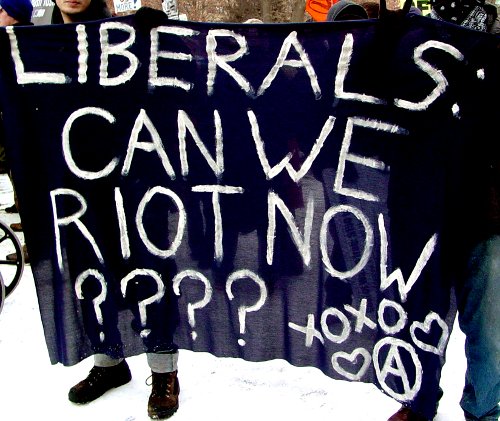
The Socialist Critique of Occupy
All of us who participated in Occupy know how difficult it was to attempt to have an impact on the movement which was so large, so geographically expansive, so varied in social composition and political ideologies, and so committed to its populist forms of the general assembly and the autonomous action committees. Nevertheless, it was important at the time and is important now to make clear what we have seen as the movement’s strengths and weaknesses, many of which we have already described here. The lack of a democratic structure by means of which Occupy activists might have discussed ideas, adopted strategies, and chosen leaders has severely hampered the movement. While consensus can be a valuable method in certain types of organizations or as a stage in certain processes, in Occupy it has led to the “tyranny of structurelessness,” thwarting attempts to give the movement purpose and direction.
Leadership, that is, the lack of leadership, has also been a serious problem. The Occupy movement threw up leaders of all sorts, good, bad and indifferent, but Occupy’s official “leaderless” position has made it impossible to have a politically accountable, transparent and responsible leadership. Consequently without a democratic structure and without any clear and accountable leadership of the movement as a whole, in each city leadership was seized by or fell to autonomous action committees and affinity groups each of which pursued its own course. While there has been a lot of energy and creativity, and often class consciousness and combativity in those actions, all of that has tended to be diffused and dissipated in the kaleidoscopic variety of lectures, cultural events, marches, protest demonstrations, and civil disobedience actions. Occupy was in the famous phrase the “carnival of the oppressed,” but it was not the hammer of the oppressed.
Without a structure and without leadership, Occupy has proven incapable of putting forward either a strategy of struggle or a political program for the movement. The brilliant 99% slogan, the critique of social inequality, and the demand to get money out of politics, captured the imagination of the public. Occupy—and this was its great strength—tended to take up all of the important social issues facing us, from unemployment to housing , from education to health care, and many other issues large and small. Yet Occupy has failed to turn these ideas into a viable political program, that is, an alternative political economy which might have appealed to the American public. At the same time, it has failed to develop a strategy of struggle that might have taken the movement from the occupation of the parks to large scale confrontations with economic and political institutions.
Another problem has been that Occupy’s social composition in most places remained predominantly white. By and large, Occupy has failed to find a way to engage African American, Latino and immigrant communities. While in most cities African Americans and Latinos were among the leaders of Occupy, and while in some places activists of color rallied to the movement, still Occupy never had a deep involvement in communities of color. To its credit, Occupy in various cities created Occupy the Hood groups, many of them led by African American and Latino activists. Yet, those groups have had limited success in most places. Women and LGBT activists in many cities also complained that they suffered both exclusion from the leadership and harassment as participants, but also that they were told that their issues were divisive. Occupy has had less success in addressing that problem.
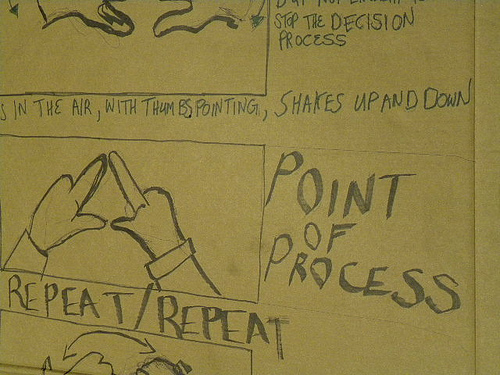
Why Has Occupy Stalled and Where Do We Go Now?
The principal reason that Occupy has stalled in most areas was simply the tremendous repression of the movement coordinated at the highest levels of the U.S. government and executed by state and local authorities – the sweeping of the occupiers from the parks, the enormous number of arrests, the violent physical attacks with truncheons, tear gas, and in some instances the firing of rubber bullets. When the Occupiers had been driven from the public spaces, the police occupied them. Behind all of this was a massive surveillance of the Occupy movement accompanied by schemes and plots created by police and agents provocateurs to entrap Occupy activists and then charge them with terrorism. Mostly Occupy failed to achieve all that it might have because it was violently strangled in the cradle by the police.
No one wants to be the coroner of Occupy charged with pronouncing it dead, but at the moment its vital signs are weak. The movement has lost its power to attract and to mobilize the tens of thousands that it did less than a year ago. Its vitality and creativity appear to have ebbed, its numbers seem to be shrinking, and consequently it has ceased to be so prominent in the press. In many areas, where Occupy once stood out as the symbol of opposition to the system or the establishment as a whole in all of its manifestations, it has now been reduced to working in a number of single issue campaigns, frequently in anti-gentrification movements of the working class and the poor of the center city.
As we write, at the end of July 2012, it seems unlikely that Occupy will be revived, though it might be. The question then becomes, what do we believe can be saved from the Occupy experience? First, we can save the lessons that we have attempted to draw out here, recognizing the great strengths of Occupy as one of those rare and beautiful social movements that rises up to challenge the system as a whole, but that in this case, unfortunately, was smothered in the cradle by state repression before it could mature enough to address the challenges it faced. Second, we can attempt to save the cadres created by Occupy, the men and women, young and old, who rallied to Occupy, saw the light, recognizing that the problem was the system of capitalism, becoming activists, and being transformed by the experience. We know that there will be other mass movements from below against this system, and we know that we will need more socialists to help provide leadership to the movement.
Dan La Botz is a Cincinnati-based teacher, writer and activist. He is a member of Solidarity’s National Committee.
Robert Brenner is the author of The Boom & the Bubble (2002), The Economics of Global Turbulence (2006), Property & Progress (2009), and an editor of Against the Current. He is also the director of the Center for Social Theory and Comparative History at UCLA.
Joel Jordan was a leader of United Teachers Los Angeles for several decades, where he built successful rank-and-file efforts to win the union to an orientation of community partnerships to preserve and improve public education. He was active in the campaign for the Millionaire’s Tax.

Comments
8 responses to “The Significance of Occupy”
http://www.villagevoice.com/2012-08-29/news/occupy-year-two/
Note the “vanguardist” comments here by activists.
For a concrete example of how Occupy’s dispersal has now “infected” other initiatives/movements/struggles with its spirit, see:
http://www.indybay.org/newsitems/2012/08/28/18720431.php
http://www.indypendent.org/2012/07/24/sunset-park-tenants-launch-rent-strike
Nick is correct that the current single-issue organizing does not, in itself, create spaces for discussion of explicitly anti-capitalist politics. However, this is the situation socialists and other anti-capitalists face MOST OF THE TIME. We need to figure out forums where that discussion can take place– through existing socialist groups, or, preferably through broader radical/anti-capitalist educational networks that can include new activists from these single-issue struggles. Not easy, but the situation we need to face!
Thanks for your thoughtful comments, Charlie. I have a less optimistic view of the single-issue groups (like the anti-foreclosure working groups) that have come out of Occupy. It’s not untrue that these campaigns serve to train activists and build deeper connections with social layers that Occupy didn’t at first connect with. However, the lack of a space to articulate a general systematic critique leaves a huge hole in the movement. To my mind, what was most exciting about Occupy which led to the activation of lots of new people was the visible expression of class anger and political disenchantment with the system as a whole, which is just no longer present. This absence feels like a setback to me, and I think has led to a lot of the people who became involved with Occupy dropping away. To me, the thing which made Occupy interesting and exciting to new activists was the systematic critique. I’m certainly in favor of building single-issue struggles around immediate demands, but viewing that as the primary thing that’s necessary seems to me to miss the very feature which made Occupy take off, and which made it appear so promising to me as a revolutionary.
-Nick D. (Baltimore)
First, many thanks to Bob Brenner, Joel Jordan and Dan LaBotz for producing this essay. The general analysis and political thrust of the document is absolutely correct. However, I think a number of points need to further clarification and discussion:
1. I am very happy that you did not describe the Oakland port shut-down as a “general strike.” The Occupy movement, with the essentially passive support of the mostly African-American longshore workers in ILWU 10 was able to disrupt dock operations for 24 hours. We should cheer the event as a precursor of what workers, if they are willing to disrupt production, can do. However, the port disruption was not the result of the self-organization and self-activity of the dock workers—no less of broader sections of the Bay Area working class. This distinction is important, but not for the reasons many left-wing apologists for the ILWU leadership have given. The action was not “substitutionist,” but in its present form it is not replicable in other areas. While potentially inspiring rank-and-file activists in the Bay Area labor movement (and beyond) to organize independently of the officialdom, only such a movement can build actual mass strikes.
2. We need to pay much closer attention to the Occupy-ILWU coalition in Longview. While the ILWU international officialdom did succeed in imposing a bad settlement in Longview, the local officials in Longview actually organized and mobilized their ranks—including direct actions against scab operations in alliance with Occupy. We need to have an analysis of how such a local leadership emerged and how it forged links with Occupy. This is especially important given the role that ILWU officials in the rest of the northwest played—trying to physically disrupt joint meetings of Occupy and ILWU activists.
3. Socialist criticism of the “anti-politics” in Occupy needs to be deepened. I am very concerned that the lack of an alternative politics will leave many Occupy activists open to appeals to campaign for Obama and the Dems in order to “defeat the right.” “Anti-politics” has never been an adequate defense against “lesser-evilism” in the electoral arena.
4. One of the biggest gains of Occupy is the highly uneven renewal of the ‘militant minority.’ While unable to maintain the occupations or win many concrete goals (a problem with not having concrete demands), Occupy has produced a new layer of activists and organizers in some areas (but not all).These folks want to build a movement with social power capable of turning back the neo-liberal offensive. While still scattered and lacking a coherent political vision and strategy, this new layer of militants has the potential of rebuilding the struggle on a medium and long-term basis. The socialist left needs to be engaging in comradely discussions with these new activists—both to share our historic understanding of capitalism and class struggle, and to learn from the insights they are generating.
5. In these discussions, socialists and other Occupy activists need to grapple with why Occupy was unable to counter the efforts of the Democrats and the labor officials to derail the movement. I believe that the absence of a substantive layer of rank and file militants in the workplaces/oppressed communities who can take action independently of the bureaucracy was key to the defeat of both Occupy and the Wisconsin uprising in the Winter of 2011. In the absence of such a layer, the potential allies for Occupy were limited to the reformist officials and their Democratic allies. Rebuilding this layer remains strategically central to the revival of working class struggle and radicalism in the US.
6. Finally, I do not agree that Occupy activists have “been reduced to working in a number of single issue campaigns.” This turn to concrete struggles is absolutely necessary if the new militants radicalized in Occupy are to help reach out and help organize a more substantial layer of activists. The tradition of “socialism from below” has always understood that it is through struggles around immediate demands that broader layers of workers and the oppressed become active, organize themselves and become open to radical and revolutionary ideas.
The placement of the “liberals can we riot now” banner in this post can be blamed on the person that formatted the article for the website (erm, me…), not the authors. That said, I remember the image going viral on Occupy-related Facebook groups in early 2012, and I think it captured one side of the tension in that debate around the awful Chris Hedges “cancer” article (as well as tactical differences that came up organically in the movement). Thanks for the clarification, though!
yes, the absence of may day other than mentioning the arrests in cleveland, and the repression post-m1 in seattle is definitely there.
also the use of the “liberals can we riot now???” banner from the early 00’s anti-globalization movement is funny. i know who made that banner and it wasn’t in 2011/2012.
i got to totally agree about independent/anti-capitalist movements from below are going to look more like Occupy and the IWW. i think the major thing that they have to drop is the more “radical liberal” politics of previous movements that want to use consensus, and all the other activist trappings.
the division of labor of moving into occupy themed single issues actually seems like a good step forward. though also more popular assemblies of unemployed/underemployed youth-workers and solidarity networks around day to day grievances might also be a fresh way to start stuff up.
not to mention there will be many students returning and starting school again for another year without a future…
I disagree with this conclusion, which says Occupy needed to develop demands, but that when we did (through committees and subcommittees), we became single issue! Of course we are going through transformation, and Occupy will be unable to maintain the pace that we had in the first heady days. People have to work, go to school, wash clothes, take care of their children, etc. On the other hand, I know through our eviction defense work, we are more rooted in neighborhoods than we were in our early days.
I do think that accountability within Occupy is a problem–but we are still finding our way.
I would say the union leaders felt more threatened by Occupy than vice-versa. I also don’t think the ILWU turned “against” Occupy; it’s more complicated than that. There was also no discussion of May Day and the general strike debate in this piece, which is puzzling.
Far from being “reduced” to single-issue campaigns for working people, I would argue that this is the only way to become truly effective. This is what it means to merge with the working class, to become rooted where we live and work, especially since the unions in this country are in terminal decline. The class war in the 21st century is going to look more like Occupy, more like the I.W.W. of old or the early C.I.O, than it is going to look like the tame crap that passed for a labor movement in the post-WWII era.